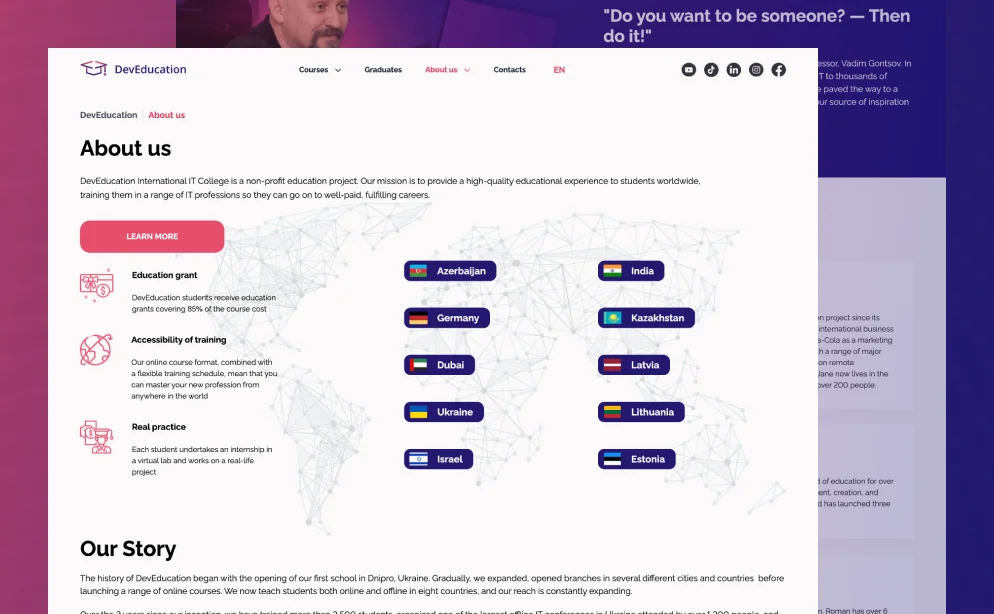Even the most high-performing teams will revert to earlier stages in certain circumstances. Many long-standing teams go through these cycles many times as they react to changing circumstances. For example, a change in leadership may cause the team to revert to storming as the new people challenge the existing norms and dynamics of the team. The stages of group development in organizational behavior and management comprise the theory of team development.

Changes, such as members coming or going or large-scale changes in the external environment, can lead a team to cycle back to an earlier stage. If these changes – and their resulting behaviors – are recognized and addressed directly, teams may successfully remain in the Performing stage indefinitely. According to this model, teams might begin a given period of development at different stages and spend different amounts of time in the various stages. Teams are not always expected to progress in a linear fashion through all of the stages. The TEAM model identities a total of nine stages, seven central ones supplemented by two additional ones. If teams get through the storming stage, conflict is resolved and some degree of unity emerges.
Norming stage
While some academics agree that there are developmental stages, they may not be as distinct or concrete as in Piaget’s theory. Piaget included the idea of a schema into his theory of cognitive development. Piaget believed four stages of group development that children remain egocentric throughout the preoperational stage. This means they cannot understand that other people think in different ways to them or that events that take place are not always related to them.
In the norming stage, consensus develops around who the leader or leaders are, and individual member’s roles. Interpersonal differences begin to be resolved, and a sense of cohesion and unity emerges. Team performance increases during this stage as members learn to cooperate and begin to focus on team goals.
Establish your team’s mission early
They may be feeling some anxiety because of uncertainty about their individual role or future responsibilities. They may feel sadness or a sense of loss about the changes coming to their team relationships. And at the same time, team members may feel a sense of deep satisfaction at the accomplishments of the team.
On the Road (Show) Again: Teaching Hockey and Fun Seattle … – NHL.com
On the Road (Show) Again: Teaching Hockey and Fun Seattle ….
Posted: Thu, 12 Oct 2023 06:46:31 GMT [source]
In this stage, team members are in the process of learning how to work together. As team members begin collaborating, conflicts may arise, whether that’s from clashing personalities or opinions on how a project should progress. Without a clear understanding of what role each individual plays on the team, relationships can get tumultuous as team members struggle to find a role that’s right for them. Gersick’s study of naturally occurring groups departs from the traditionally linear models of group development. Her punctuated equilibrium model (Gersick, 1988, 1989, 1991) suggests that groups develop through the sudden formation, maintenance, and sudden revision of a “framework for performance”.
The 5 stages of group development
To get through this stage, members must work to overcome obstacles, to accept individual differences, and to work through conflicting ideas on team tasks and goals. Once a group receives the clarity that it so desperately needs, it can move on to the third stage of group development, known as the norming stage — where the group becomes https://www.globalcloudteam.com/ a cohesive unit. Morale is high as group members actively acknowledge the talents, skills, and experience that each member brings to the group. A sense of community is established and the group remains focused on the group’s purpose and goal. Leadership is shared, and members are willing to adapt to the needs of the group.
Setting a goal, even before you start working together, establishes some ground rules to focus on and ensures that everyone is on the same page and moving towards the same goal. Psychologist Bruce Tuckman was the first to document the different phases that teams go through as they develop. In this article, we discuss the different stages of group development and how you can guide your team through them to optimize collaboration. United Nations’ Secretary-General António Guterres reported at the UN General Assembly that just 12 per cent of the Sustainable Development Goals are on track – with 30 percent stalling or having worsened in the past decade (5). The last stage indicates that after the team has served its purpose, it will eventually be disbanded or de-formed.
Stage 4: Performing stage
And, if you liked this blog post, share it with someone who might find it useful. During the Norming stage, members shift their energy to the team’s goals and show an increase in productivity, in both individual and collective work. The team may find that this is an appropriate time for an evaluation of team processes and productivity. This is where it’s important to level with individual contributors and truly get to know what’s going on. This is a great time to reflect on what makes a high-performing team able to accomplish tasks and move through obstacles.
There may be regret as the team ends, so a ceremonial acknowledgement of the work and success of the team can be helpful. If the team is a standing committee with ongoing responsibility, members may be replaced by new people and the team can go back to a forming or storming stage and repeat the development process. The first stage of group development is known as the forming stage — a time when the group is just starting to come together and is characterized by anxiety and uncertainty.
What is a brand voice? Plus, 7 tips to develop one
Sometimes, subgroups may form around particular opinions or authority figures. In fact, all these are clear signs that team cohesion has not happened yet. Unless the team is patient and tolerant of these differences, the team and project can’t succeed. Here’s the thing, the line between certain stages can get blurred since team members evolve at different times. After the storming stage, they recognize behavioural patterns, strengths and develop foresight for upcoming roadblocks.
- It is important to note that Piaget did not view children’s intellectual development as a quantitative process.
- The rest of the team gets feedback from SEO Wizard Daisy about the high performance of most articles, helping the company rank for the most relevant keywords.
- How did you know what behaviors were acceptable or what level of performance was required?
- Team members should continue to deepen their knowledge and skills, including working to continuously improving team development.
- The second stage of group development is known as the storming stage — where conflict and competition are at their greatest.
- Psychologist Bruce Tuckman was the first to document the different phases that teams go through as they develop.
Here, individuals exit from the group (separately or
simultaneously) and the team loses its identity and ceases to exist. However, there is an adjourning stage for temporary committees, teams, task forces, and similar groups that have a limited task to perform. It is important to note that Piaget did not view children’s intellectual development as a quantitative process. That is, kids do not just add more information and knowledge to their existing knowledge as they get older. While children are still very concrete and literal in their thinking at this point in development, they become much more adept at using logic.
Schema
For example, a child who understands cause and effect may intentionally shake a rattle to make a noise or cry in order to gain attention. Jean Piaget was a renowned psychologist and cognitive theorist in the 20th century who focused on child development. His theories came from observing children and recording their development. The most productive of all, the Performing Stage yields immense benefits for the tasks and goals you established in the first 3 stages. At first, people are led by their natural desire to be liked by others and accepted among their peers.
